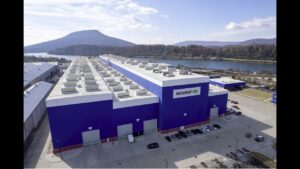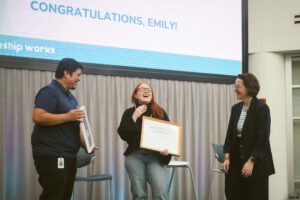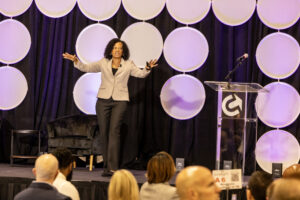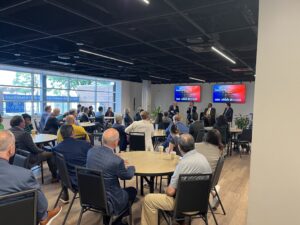Marley Lentz, Office Furniture Warehouse
The best performing workplaces in the world consistently offer a specific type of workplace experience — a participatory space where infrastructures are crafted, immersive and user-centric. But, is the physical space alone enough to create an outstanding workplace experience? The simple answer is no. You can create the ideal physical infrastructure but still be left with employees whose experience is less than average. Why? Because there are other factors that will have an impact on the overall experience. (Leesman 2018)
At Office Furniture Warehouse, we’re here to make your workspace work as hard as you do. Sometimes that’s furniture, sometimes that’s summarizing an ungodly amount of research into the three main components of an employee’s experience in the built environment. Let’s examine the activities, physical and service features that more than 2 million data points suggest are the best way to cultivate an excellent workplace experience.
Leesman is an organization that collects data from employees around the globe – measuring feedback about how the workplace supports them, providing organizations with insights to improve upon and benchmarking results in the largest employee experience database in the world.
The organization recently published a comprehensive analysis of the “workplace experience framework”. The study collected responses from nearly a half million global employees, mapping a complex web of factors that contribute to employee sentiment toward the workplace. Based on the weight of responses, Leesman isolated the elements of an exceptional workplace experience.
Individual, Focused Work & Disconnecting
While the majority of activities outlined in the responses to Leesman's workplace survey are collaborative or participatory, individual work's impact exceeded everything by a considerable margin. On the opposite pole of activities, the ability to disconnect is ranked as a “super-driver” of workplace experience. Catering to both solo concentration and time to recharge is essential.
Learning from Others, Planned Meetings & Ideation
Theoretically, an environment that supports knowledge transfer also increases employee’s efficacy. An environment where peers who work in similar areas are placed together increases individual productivity. Thus, we're interpreting the high impact of participatory activities as a need for collaborative spaces to turn information into knowledge
Individual Workstations
It comes as no surprise that individual workspace is valued just as highly as the activity of working individually. We believe this has more to do with employees' locus of control. The findings reported that the most impactful driver of employee experience when it comes to physical workplace features are individual workstations and the ability to customize them. When employees can exercise a degree of control over their workspace, they feel more comfortable.
Décor
Of all visual cues, Leesman found office décor has highest potential to influence a positive workplace experience. Unfortunately, only 43 percent of respondents globally indicated satisfaction with their workplace's general décor. A well-branded workplace works as a constant brand ambassador. When employees are immersed in an environment that’s clearly unique to their company, they feel a deeper sense of pride in being part of the team. When visitors understand what your organization is about and where it's going within moments of being in the workspace, the effect is compounded.
Break Out & Small Conference Spaces
Work today is not linear – employees bouncing between individual focused work and collaborative tasks is par for the course. Sometimes this is structured but, more often than not, working days evolve minute to minute. 78.2 percent and 52.5 percent of respondents indicated the importance of small meeting rooms and informal work areas, respectively. However, reported satisfaction levels are only 53 percent (small conference rooms) and 38.2 percent (informal work areas). The key to an appropriate balance of collaborative spaces is an understanding of teams' dynamic nature. Then, implementing an optimal mix of spaces that cater to size and purpose. This way, employees can work individually or collaboratively in spaces they deem most suitable for their present scenario. This goes back to a larger locus of control influencing levels of comfort – let them choose and watch their productivity soar.
While over half of employees globally rank them as important, only 38.2 percent are satisfied with informal work areas and break out zones. Similarly, 78.2 percent consider small meeting rooms important with a significantly lower satisfaction rating of 53 percent.
Service Features of Workplace
Leesman's final data points out what drives employee sentiment. It often includes features that become neglected in the workplace. The highest ranked service features are tidiness, refreshments and restrooms.
Of the service features, tea, coffee and other refreshment facilities marginally achieved lead position as the foremost driver. Clearly, it’s… a crucial component in relaxing, collaborating, hosting visitors and even individual work. So, the impact that a good coffee experience can have on employees’ experience should not be underestimated. The data highlights again the importance of general tidiness, appearing as the second most impactful service feature. (Leesman 2018)
Leesman attributes tidiness' ranked impact to employees' perception of their ability to get things done. Data suggests that workplace tidiness is highly influential in employees’ sense of organizational productivity.
Another service driver of employee experience is the availability of refreshment facilities, which we believe speaks again to employees' perception of the workplace and the image it projects. That's the future – hardwiring social culture into corporate culture.








